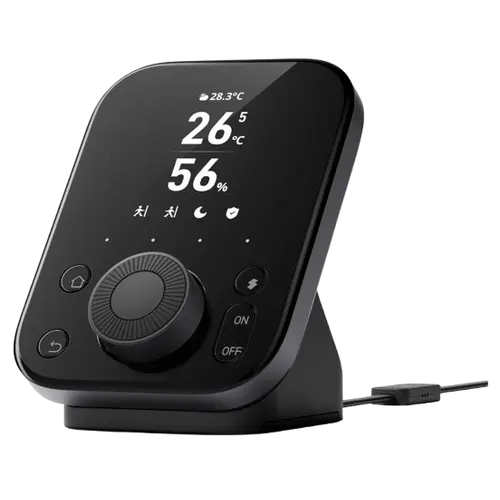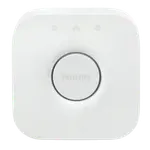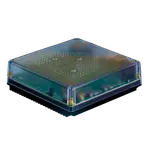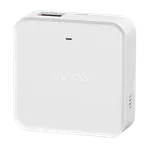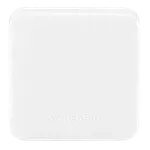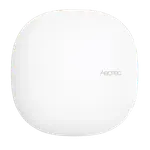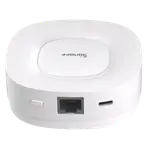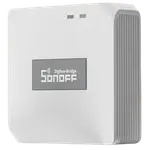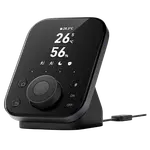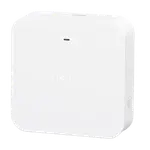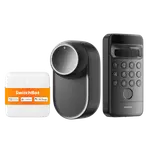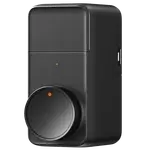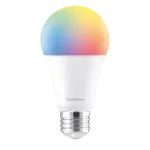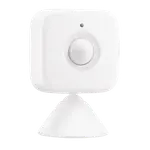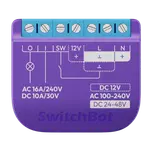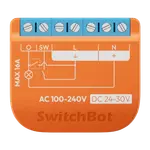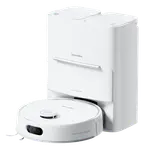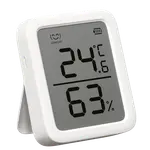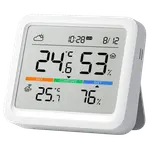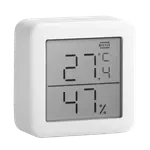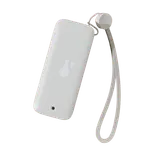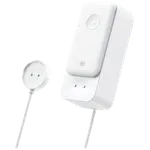SwitchBot
Hub 3
Launch Year: 2025
Summary
Size & Materials: 190g / 6.7oz, 126 x 94 x 38 mm
Connectivity: 2.4 GHz Wifi
Protocols: Bluetooth, Matter Bridge, IR
Integrations: Google Home, Alexa, Apple HomeKit, Samsung SmartThings, Home Assistant
Sensors: Temperature, Humidity, Light, Motion
Price History
Loading price history...
| Brand | SwitchBot |
|---|---|
| Headquarters | |
| Website | https://www.switch-bot.com |
| @SwitchBot |
Size & Materials
Length x Width x Height
- Length: the longest side of the device
- Width: the shorter side of the device
- Height: the vertical dimension of the device
126 x 94 x 38 mm
The physical weight of the device, typically measured in grams (g) or ounces (oz).
Weight can be important for installation considerations, especially for wall-mounted or battery-powered devices.
190g / 6.7oz
Hardware
The central processing unit that handles the hub's computing tasks.
A more powerful CPU enables faster processing, better multitasking, and support for more connected devices.
?
Random Access Memory (RAM) used for temporary data storage and processing.
More memory allows the hub to handle more simultaneous connections and run more complex automations smoothly.
?
Internal storage capacity for system files, logs, and local data.
Additional storage space allows for more extensive local processing, longer history retention, and offline capabilities.
?
A slot for inserting a MicroSD card to expand storage capacity.
NO
PoE port that can provide both power and network connectivity through a single cable.
Power over Ethernet simplifies installation by eliminating the need for separate power adapters.
NO
Built-in audio output for alerts, announcements, or media playback.
Integrated speakers enable voice announcements, alarm sounds, and audio feedback for hub interactions.
NO
Built-in audio input for voice commands or sound detection.
A built-in microphone enables voice control and can detect audio events like glass breaking or smoke alarms.
NO
Connectivity
Range: The 2.4 GHz band offers a longer range, meaning it can cover larger areas and penetrate solid objects like walls more effectively than 5 GHz.
Speed: Generally, 2.4 GHz provides slower speeds compared to 5 GHz due to a lower maximum data rate.
Interference: More prone to interference since many other devices (like cordless phones, microwaves, and Bluetooth devices) operate on the 2.4 GHz frequency, leading to potential congestion and slower network performance.
YES
Range: Offers a shorter range compared to 2.4 GHz and may have difficulty penetrating walls and other obstacles.
Speed: Typically provides faster speeds and higher data rates due to more available bandwidth.
Interference: Less prone to interference as fewer devices operate on this frequency, leading to a more stable connection.
NO
Ethernet is a widely used technology for wired networking, providing a stable and high-speed connection between devices on a local area network (LAN).
Speed: Ethernet can offer higher and more consistent speeds compared to Wi-Fi. Modern Ethernet standards can support speeds from 100 Mbps (Fast Ethernet) to 10 Gbps (10 Gigabit Ethernet) and beyond.
Stability and Reliability: Because it uses a wired connection, Ethernet is less susceptible to interference from other devices and physical barriers, leading to a more stable and reliable connection.
Lower Latency: Ethernet typically offers lower latency compared to Wi-Fi, making it ideal for applications that require real-time data transfer, such as online gaming and video conferencing.
Security: A wired connection is generally more secure than a wireless one, as physical access to the network is required to intercept data.
NO
Protocols
Bluetooth is a wireless communication technology used for exchanging data over short distances.
Bluetooth enables devices to communicate wirelessly within a short range, typically up to 10 meters (about 33 feet) for most consumer devices.
YES
Zigbee is a wireless communication protocol designed for low-power, short-range applications, commonly used in smart home devices, industrial automation, and other areas requiring reliable, low-data rate communication. It features low power consumption, making it ideal for battery-operated devices, and supports short-range communication, typically up to 100 meters. Zigbee employs mesh networking, allowing devices to hub data through each other to extend range and improve reliability. It supports data rates up to 250 kbps, suitable for small data packets, and ensures interoperability among devices from different manufacturers if they conform to Zigbee standards. Security is robust, with AES-128 encryption for data protection.
Z-Wave is known for its low power consumption, making it ideal for battery-powered devices. It supports a mesh networking topology, allowing devices to communicate with each other directly or through intermediary nodes, thus extending the overall network range and enhancing reliability. The protocol supports data rates of up to 100 kbps, suitable for transmitting control commands and sensor data.
NO
Zigbee is a wireless communication protocol designed for low-power, short-range applications, commonly used in smart home devices, industrial automation, and other areas requiring reliable, low-data rate communication. It features low power consumption, making it ideal for battery-operated devices, and supports short-range communication, typically up to 100 meters. Zigbee employs mesh networking, allowing devices to hub data through each other to extend range and improve reliability. It supports data rates up to 250 kbps, suitable for small data packets, and ensures interoperability among devices from different manufacturers if they conform to Zigbee standards. Security is robust, with AES-128 encryption for data protection.
Zigbee devices need a Zigbee-compatible hub to connect and communicate with other devices in your smart home setup.
NO
Thread is a wireless communication protocol designed specifically for Internet of Things (IoT) devices, providing secure, reliable, and scalable networking. Unlike some other protocols, Thread is IP-based, which means it can seamlessly integrate with existing internet infrastructure. It operates in the 2.4 GHz frequency band and uses mesh networking to enhance reliability and extend range by allowing devices to hub data through each other.
Thread is optimized for low power consumption, making it suitable for battery-operated devices. It supports low-latency communication, which is crucial for real-time applications like home automation and security systems. The protocol ensures high security with AES-128 encryption and end-to-end security at the network layer. Thread also supports over-the-air updates, ensuring devices can stay up to date with the latest features and security patches.
Thread-enabled devices require a Thread Border Router (such as certain smart home hubs or routers) to connect to your home network and other Thread devices.
NO
Matter is a unified, open-source connectivity protocol designed to standardize and simplify communication between smart home devices from different manufacturers. Developed by the Connectivity Standards Alliance (formerly the Zigbee Alliance), Matter aims to improve interoperability, security, and reliability across various smart home ecosystems.
Matter operates over existing networking technologies, including Ethernet, Wi-Fi, and Thread, providing flexibility in device connectivity. Its IP-based nature allows seamless integration with existing internet infrastructure and cloud services. Matter uses a mesh networking topology, particularly when operating over Thread, to enhance range and reliability by allowing devices to hub data through each other.
Security is a cornerstone of Matter, with end-to-end encryption and secure device onboarding processes ensuring robust protection for data and privacy. Matter also supports over-the-air updates, allowing devices to stay current with the latest features and security enhancements.
YES
Infrared capability for controlling IR-enabled devices like TVs and air conditioners.
IR control allows the hub to operate traditional remote-controlled devices, expanding smart home integration.
YES
With Smart learning mode, it can mimic your existing remote control in 5s.
Integrations
Google Home serves as a central hub for a variety of smart devices, including lights, thermostats, cameras, and speakers. It leverages Google Assistant for voice control, enabling users to manage their smart home with simple commands.
YES
Amazon Alexa is one of the most widely used smart home systems, known for its compatibility with a vast array of devices. Users can control everything from smart lights to appliances using voice commands through Echo devices.
YES
Apple HomeKit is designed for users in the Apple ecosystem, providing a seamless way to control compatible smart devices through iOS devices using the Home app or Siri. It emphasizes security and user privacy.
YES
SmartThings is a flexible platform that connects a wide range of devices from different brands, offering a unified interface for control. It supports various communication protocols, allowing for extensive device compatibility.
YES
Home Assistant is an open-source platform that allows for extensive customization and integration of a wide variety of smart devices. It supports a multitude of protocols and brands, making it ideal for tech-savvy users.
YES
Sensors
Measures ambient temperature in the surrounding environment.
Temperature monitoring helps maintain comfortable conditions and can trigger heating/cooling automations.
YES
Measures relative humidity levels in the air.
Humidity monitoring helps prevent mold growth and maintains optimal indoor air quality.
YES
Built-in light sensor for ambient light detection and monitoring.
Light sensors can automatically adjust device behavior based on lighting conditions and provide environmental monitoring data.
YES
Built-in motion sensor for detecting movement in the hub's vicinity.
Motion sensors enable automated responses to presence detection and can trigger scenes or security alerts when movement is detected.
YES
Features
Maximum number of individual devices that can be connected to and managed by the hub.
Higher device capacity allows you to build larger smart home systems with more sensors and controllers.
30
Support for ONVIF protocol cameras for universal IP camera integration.
ONVIF support allows integration with a wide range of IP cameras from different manufacturers.
NO
Support for RTSP (Real-Time Streaming Protocol) cameras.
RTSP support enables integration with professional and prosumer IP cameras for advanced surveillance systems.
NO
Support for Node-RED visual programming environment for advanced automations.
Node-RED support enables complex automation logic and integration with numerous third-party services.
NO
Built-in Tailscale VPN support for secure remote access.
Tailscale integration provides secure, encrypted remote access to your hub without complex network configuration.
NO
Compare smart hubs by supported protocols, connectivity, hardware specs, integrations, automations, and compatibility with platforms like Matter, Zigbee, and Thread.
![SwitchBot Meter Pro (CO2 Monitor)]() SwitchBot
SwitchBotMeter Pro (CO2 Monitor)
![SwitchBot Lock Ultra Vision Combo]() SwitchBot
SwitchBotSwitchBot Lock Ultra Vision Combo
![SwitchBot Lock]() SwitchBot
SwitchBotSwitchBot Lock
![SwitchBot Lock Pro]() SwitchBot
SwitchBotSwitchBot Lock Pro
![SwitchBot Contact Sensor]() SwitchBot
SwitchBotContact Sensor
![SwitchBot Hub 2]() SwitchBot
SwitchBotSwitchBot Hub 2
![SwitchBot Hub Mini]() SwitchBot
SwitchBotHub Mini
![SwitchBot Hub 3]() SwitchBot
SwitchBotHub 3
![SwitchBot Hub 2]() SwitchBot
SwitchBotSwitchBot Hub 2
![SwitchBot Hub Mini]() SwitchBot
SwitchBotHub Mini
![SwitchBot Hub 3]() SwitchBot
SwitchBotHub 3
![SwitchBot Color Bulb]() SwitchBot
SwitchBotColor Bulb
![SwitchBot Motion Sensor]() SwitchBot
SwitchBotMotion Sensor
![SwitchBot Plug Mini]() SwitchBot
SwitchBotPlug Mini
![Switchbot Relay Switch 1]() SwitchBot
SwitchBotRelay Switch 1
![Switchbot Relay Switch 1PM]() SwitchBot
SwitchBotRelay Switch 1PM
![Switchbot S20]() SwitchBot
SwitchBotS20
![SwitchBot Meter Plus]() SwitchBot
SwitchBotMeter Plus
![SwitchBot Meter Pro]() SwitchBot
SwitchBotMeter Pro
![SwitchBot Meter]() SwitchBot
SwitchBotMeter
![SwitchBot Indoor/Outdoor Thermo-Hygrometer]() SwitchBot
SwitchBotIndoor/Outdoor Thermo-Hygrometer
![SwitchBot Water Leak Detector]() SwitchBot
SwitchBotWater Leak Detector
![Switchbot Water Leak Detector (Sensor Cable Edition)]() SwitchBot
SwitchBotWater Leak Detector (Sensor Cable Edition)

